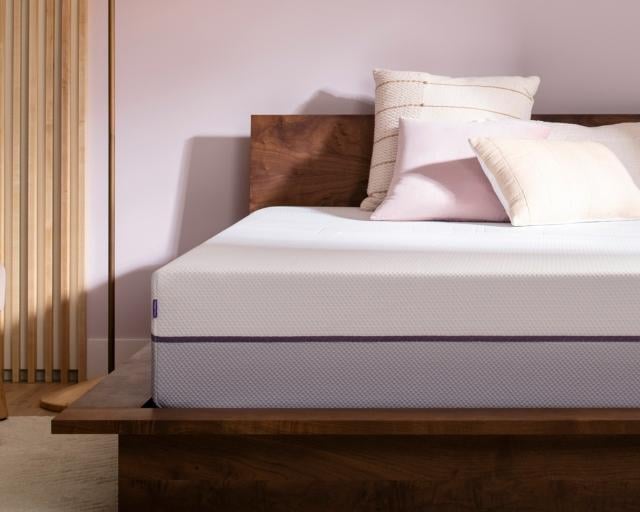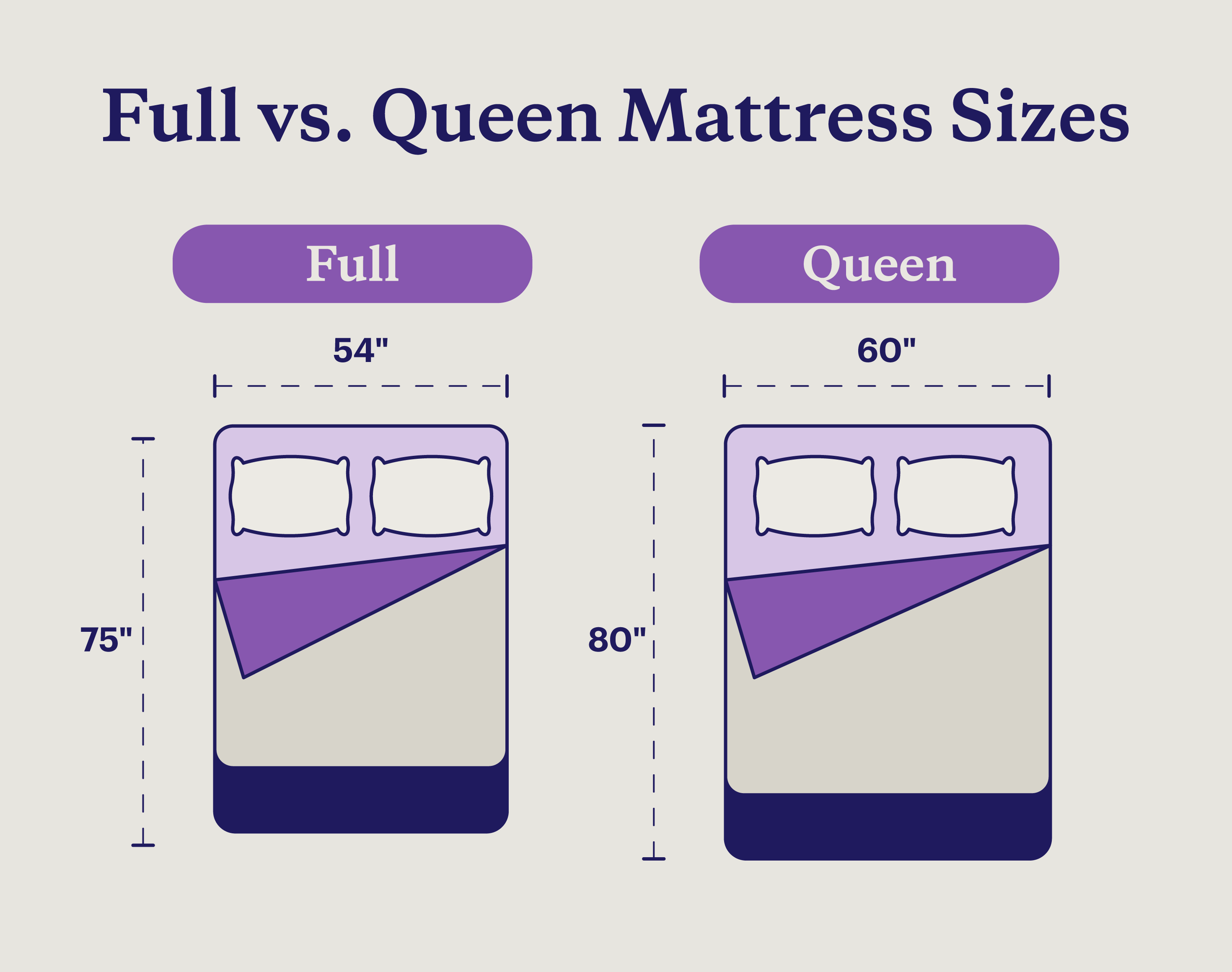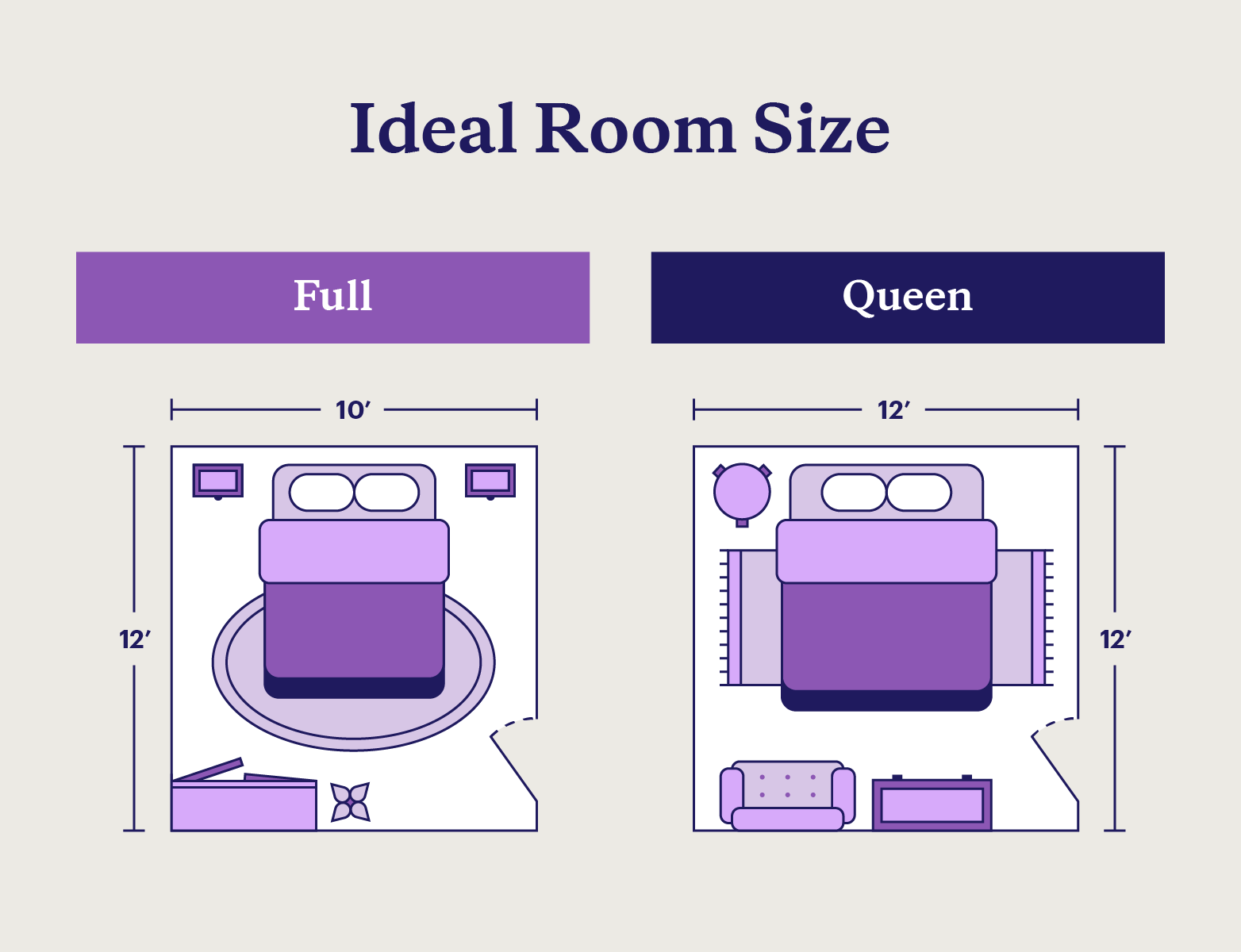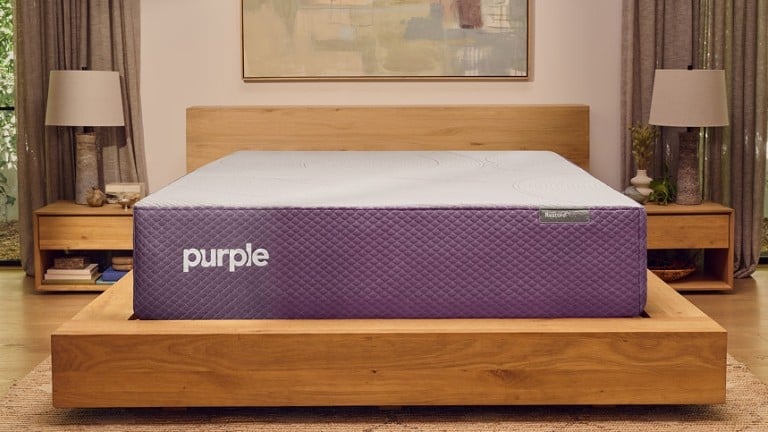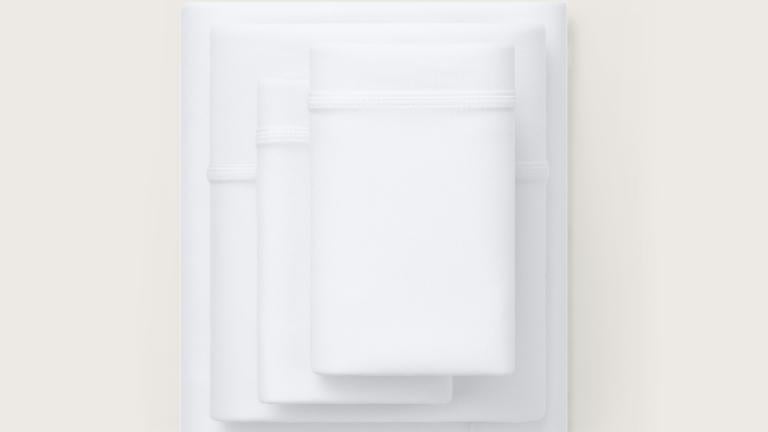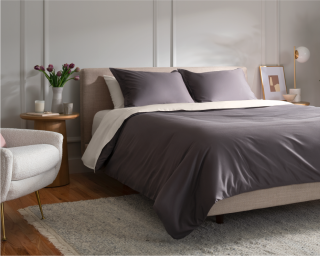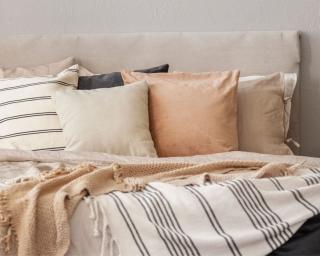
Queen vs. Full Mattress: Which Size Is Best for Couples?
Key Takeaways
- Queen mattresses are larger than full beds, measuring 60-by-80 inches with a surface area of 4,800 square inches.
- Full mattresses measure 54-by-75 inches with a surface area of 4,050 square inches.
- Full beds work well for teenagers, single young adults, and small guest bedrooms, while queen mattresses are better for couples.
Everyone has different sleep needs, and one mattress size doesn’t fit all lifestyles. When comparing queen vs. full mattresses — two of the most popular sizes — it’s important to consider how they work for you.
Full mattresses are smaller than queens in width and length. The queen’s extra space makes it the most popular bed size for couples, whereas a full fits better in bedrooms smaller than 10-by-10 feet.1
On average, a good mattress lasts a decade, so do your research and choose the right one for your needs. In this article, we’ve compared full vs. queen mattresses for size, pricing, comfort, and other key factors so you can have full confidence going into your decision.
Full vs. Queen Bed Comparison
For single sleepers, teens, and guest rooms, a full mattress is comfortable without being too big. While a full mattress can fit two people, the smaller dimensions can be uncomfortable. Queen mattresses are one of the best bed sizes for couples because they offer more personal space compared to full mattresses.
The dimensions of a full size bed frame are smaller than those of a queen size bed frame, allowing them to fit better in smaller bedrooms. But if you’re looking for a bed to fill out the space in a medium or larger bedroom, opt for at least a queen bed.
Full | Queen | |
Width | 54” inches | 60” inches |
Length | 75” | 80” |
Surface area | 4,050 in2 | 4,800 in2 |
Bed frame dimensions | 56-59” x 77-80” | 62-66” by 82-86” |
Minimum room size | 9-by-9.5’ | 10-by-10’ |
Ideal room size | 10-by-12’ | 12-by-12’ |
Best for | Single sleepers, teens, small bedrooms | Couples, sprawling sleepers |
Cost | $-$$ | $$-$$$ |
Differences Between Full and Queen Size Beds
While there are many types of mattresses, size is one of the most important things to consider. For full and queen size beds, the differences come down to their dimensions, comfort features, room size, and price point.
Dimensions
The main difference between a full and queen mattress is the size. A queen mattress is 6 inches wider and 5 inches longer than a full size bed. The surface area of a queen is 4,800 square inches, while a full is 4,050 square inches — a difference of 750 square inches.
Mattress thickness is not standardized but ranges between 8 and 14 inches for a full, and up to 19 inches for a queen. Firmness also depends on the type of materials used.
Ultimately, mattress dimensions should fit your budget, comfort, accessories, and room size.
Individual Space
The best mattress size is one that provides optimal comfort. Consider your body type and how much space you want to share with your partner, co-sleeping children, or pets.
Full mattresses are great for single sleepers and can fit two people, but may not be as comfortable. Queen mattresses are better for those who require extra space to stretch and sprawl out.
Couples need more space if they move in their sleep, own pets, or sleep lightly. A queen is the preferred option for most couples' sleeping positions due to its size.
Minimum Room Size
Bigger beds require bigger bedrooms. Full mattresses fit into bedrooms of 9-by-9.5 feet or larger — a common size for guest rooms and small bedrooms — but the best size is 10-by-12 feet. Queen mattresses are a perfect fit for primary bedrooms 10-by-10 feet or larger, with the ideal size measuring 12-by-12 feet.
When it comes to nightstands, full mattresses provide ample space for two on either side of the bed in most bedrooms. A queen mattress can make it difficult to fit two side tables, depending on the size of the room.
Accessories
The difference between full and queen size accessories is minimal. They’re two of the most popular mattress sizes for the average American, which means that bed accessories –– from pillows to blankets and comforters –– shouldn’t be difficult to find.
The main difference is that queen size accessories cost more than full size ones. Queen mattresses need bigger sheets, bigger blankets, and more pillows. Full mattresses need smaller sizes and fewer accessories, though you can use standard size pillows for both mattress sizes.
Price
A queen mattress will be more expensive than a full mattress of the same quality because of its larger size. Depending on several factors, full mattresses can range from $700 to $2,800 or more, while queen mattresses typically range from $800 to $3,000 or more. Consider how much you should spend on a mattress, but make sure the mattress you choose is right for you.
Purple has three collections of mattresses available at different price ranges. While all are made with our proprietary GelFlex Grid®, also known as a GelFlex Matrix™, we've designed unique models that promote deep sleep across varying budgets. Full sizes are not available in all mattresses, but here’s a breakdown of how much full and queen size mattresses from Purple cost. Prices may change throughout the year with sales and seasonal promotions.
Purple mattress | Full | Queen |
$1,299 | $1,399 | |
$1,399 | $1,499 | |
$1,799 | $1,899 | |
$2,249 | $2,399 | |
$3,149 | $3,299 | |
N/A | $3,999 | |
N/A | $4,999 | |
N/A | $5,999 | |
N/A | $6,999 | |
N/A | $7,999 |
Queen vs. Full Bed Pros and Cons
Full and queen mattresses each come with pros and cons. About 14% of Americans use full beds, but queens are the most common bed size for most adults.1
The right choice between a queen bed vs. full bed depends on your personal preferences and lifestyle. We’ve curated a list of pros and cons so you can assess the best option for you.
Benefits | Considerations | |
Full | Relatively inexpensive
More lightweight than most mattress sizes
Good for single people
Fits into most room sizes
| Less comfortable for two adult sleepers
Less space for a couple’s children or pets
May not be a long-term solution |
Queen | Adequate space for couples
Room for children and pets
Fits comfortably in most primary bedrooms | Costs more than a full mattress
Usually heavier than a full mattress
Takes up more space |
How To Choose Between a Full or Queen Bed
When it comes to choosing your mattress size, there are a handful of factors to consider. Below, we list some of the most important factors that should inform your decision.
1. Count the Number of Sleepers
How many sleepers will be using the bed simultaneously? Although both sizes can work for couples, you may need more space for your lifestyle. A full or double bed might be perfect for single sleepers, but if you plan to upgrade soon, opting for a queen now may save you money and energy in the long run.
For couples, a queen mattress can provide adequate room while leaving space for your children and pets. A full bed may be too cramped if you plan to co-sleep with a partner, children, or pets, but if space is limited, look for cooling mattresses for couples to keep everyone comfortable.
2. Measure Your Room Size
Rooms can get cramped when a bed takes up too much space. Measure your room dimensions to determine an appropriately sized bed. Ideally, your bed should fit with enough room to walk easily and add furniture.
If your bedroom is at least 9-by-9.5 feet, you can comfortably fit a full mattress. A queen mattress fits in rooms that measure 10-by-10-feet or larger. Measure your room to determine what size bed you should get.
3. Consider Your Body’s Size
Body size counts when choosing between beds. Queen mattresses are comfortable for people up to 6 and a half feet tall. Full size mattresses are comfortable for sleepers up to 6 feet tall.
The extra 6 inches in width of a queen allows for a higher mattress weight limit, making queens more suitable for heavier individuals. You can adjust these measurements to account for your children and pets.
4. Consider Your Age
Older sleepers might need a mattress that suits their mobility needs and sleep patterns. A full mattress can provide enough room for a single sleeper who moves a lot, but older couples should consider a queen mattress that provides ample space for movement.
Mattress thickness, pressure relief, and spinal alignment are especially important for older sleepers. Opt for a mattress and bed frame that sit at a comfortable height to make it easier to get in and out of bed, and make sure the mattress provides the comfort and support you need.
5. Think About Movability
Queen mattresses can be cumbersome when it comes to moving, but full mattresses don’t lessen the burden by much. You will need a pickup truck or large van to move a mattress of either size. If you enjoy rearranging your room, a full mattress can be somewhat easier to lift and place.
6. Choose Your Firmness
The size of your mattress shouldn’t impact your firmness options, since firmness levels are offered across full, queen, and other size mattresses. While the right mattress firmness suits your personal preferences, it’s important to recognize the distinction between a firm mattress and one that provides back support.
7. Look at Your Budget
A full mattress is typically less expensive than a queen mattress. A bigger mattress means you’ll pay more for sheets, pillows, and other mattress accessories as well. Since both queens and fulls are common mattress sizes, their accessories are easy to find in most stores.
Build quality and materials can impact budgets the most — the price difference between a queen and a full is minimal when they use the same materials.
Follow the table below to help you determine if a queen or full bed is right for you.
Consider a full bed if you are… | Consider a queen bed if you are… |
A single adult | A couple who likes personal space |
Looking for a bed for a child or teen | A couple where at least one sleeper runs hot at night |
A couple who likes to cuddle | Taller than 6’ |
Furnishing a small bedroom | Single but sleep with pets or move around in your sleep |
On a tighter budget | Furnishing a medium to large bedroom |
Is It Worth Upgrading From Full to Queen?
If you’re asking yourself, “Should I get a full or queen bed?,” then you should know that the better option between a queen or full mattress depends on your preferences.
Choosing the right mattress size means you can sleep better knowing you won’t have to replace your mattress for many years to come.
At Purple, we offer a 10-year warranty, a 100-night trial, free shipping, and easy returns on all our mattresses. Remember that a mattress is an investment for your health as much as your comfort.
FAQ
No, a full is not the same as a queen mattress. A full mattress is smaller than a queen bed, measuring 54-by-75 inches. In comparison, a queen measures 60-by-80 inches, making it both wider and longer.
No, full XL and queen beds are not the same size. A full XL bed measures 54-by-80 inches, while a queen bed measures 60-by-80 inches, making queen mattresses 6 inches wider.
If you’re looking for the width that a queen offers without the length, you can opt for a short queen mattress instead of a standard queen or full XL.
A queen mattress is 6 inches wider and 5 inches longer than a full mattress. This makes a queen bed bigger than a full by 750 square inches.
Full beds are best for single sleepers. Couples can fit in a full bed if they don’t sleep lightly or don’t require much personal space. The decision comes down to your preference, budget, room size, body size, and how many other people or pets will sleep with you.
Yes, a full mattress can fit two adults who are comfortable sleeping close together. For most people, a full mattress is just enough room for two.
A full mattress might not work for adult couples who sleep lightly or move a lot in their sleep. Taller people tend to struggle to fit on a full mattress and instead opt for a queen
Yes, you can put queen sheets on a full bed in a pinch. The issue is that queen sheets are larger than full sheets, so they will fit loosely.
You can tuck extra sheet fabric under your full mattress to make queen sheets fit, but elastic sheets won’t fit snugly, ruining your chances of getting a neat corner.
More To Explore
Level up your sleep routine with our most-loved products.

